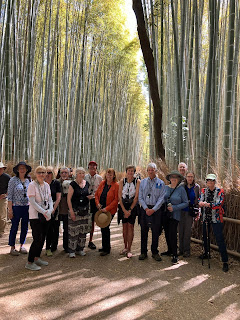Motor coach travel across Kyoto, even on a Sunday morning holiday weekend, does not move quickly. Relatively narrow streets make for traffic congestion in all conditions. But we finally arrived at our first destination, the Tenryu-ji Temple and adjacent Sogenchi Garden.
This temple is on the site of the first Zen temple in Japan, established in the 9th century C.E. The Tenryu-ji iteration of the temple was established in 1339. However, it has been destroyed by fires eight times over the past 700 years. The most recent fire was in 1864, so most of the buildings date back to around 1870.
The gardens, however, remain much as they were laid out by the temple's founding abbot in the 14th century. A key feature of the garden is a number of stones in the pond, near the waterfall, that are set up vertically. Symbolically, they represent carp (or koi fish) attempting to climb up the waterfall.
According to legend, a koi fish that reaches the top of the waterfall turns into a mighty dragon. Thus, the carp represents striving for success in life. The carp flags flying on flag poles all over the country have the same meaning.
The garden is adjacent to the Arashiyama bamboo grove. This forest of bamboo is one of the most photographed sites in Kyoto. Our tour leader spent WAY too much time ambling slowly through both the garden and the bamboo grove. We spent two hours here, and could have seen it in 45 minutes, tops.
The bus drove us on to the "Golden Pavilion," or Kinkaku-ji, officially known as the Rokuon-ji Temple. Originally a villa for a Shogun in the late 14th century, the man got religion late in life and left the villa to Buddhist monks in his will. The garden pavilion, built to receive emperors and foreign dignitaries and covered in gold leaf, was turned into a temple.
At the site, absolutely no mention is made of the fact that the 14th century pavilion was burned by an arsonist in 1950 and rebuilt in 1955. Strangely, there seem to have been very few records of the exact specifications of the original. Some have argued that the present reproduction isn't accurate.
Entrance to the temple is reserved to the monks alone, so the crowds only see the exterior and the surrounding gardens. Again, we spent way too much time here. The only explanation was that it is usually much more crowded than it was today, and so extra time is allotted in the itinerary. We spent a lot of time sitting in front of the gift shop, waiting for the bus departure time.
Lunch was a bit of a drive away, in a tiny little restaurant, off the beaten track. The food was good, but nothing memorable. The best feature, however, was that the restaurant was just a short walk to Nico-jo Castle.
The castle, complete with moat and stone walls reminiscent of Medieval European castles, was constructed 1601-1603 on orders from the first Shogun, Tokugawa Ieyasu. Tokugawa united Japan under his rule after a period of civil war, reducing the Emperor to only a ceremonial role for the next 266 years.
Because the Shoguns ruled from Tokyo, and the imperial residence was in Kyoto, the castle's main function was to keep an eye on the Emperor. But the Shoguns actually only came to the castle personally on three occasions over that 266 year period.
The first visit was in 1603 when Tokugawa dedicated the castle and was officially proclaimed as the first Shogun. The last time was in 1867 when the last Shogun came to officially proclaim the restoration of imperial rule. The only other visit was in the 1620s when the daughter of a Shogun was married to the Emperor in Kyoto.
Photos are not permitted inside the castle, but what we saw was basically a series of large tatami rooms where samurai lords awaited audiences with the Shogun, and a similar series of rooms where the Shogun actually held those meetings.
The waiting rooms were designed to intimidate. The audience hall was designed to keep the Shogun above and beyond his visitors. Other rooms were occupied by various scribes and secretaries.
After the castle, we followed Mariko and several others on a short Metro ride to the Nishiki Market. This is the "Mall of America" for Kyoto, but with much narrower walkways and lots more people. We enjoyed a nice dish of ice cream (real, not fermented rice) and enjoyed free samples of everything from honey to bean paste.
From the market back to the hotel was a 20 minute walk, or less. Most of our group gathered for "happy hour" at 6 p.m. The 7-11 across the street sells cheap wine and beer, as well as various snacks that are a surprise when opened because the labels are in Japanese.
After happy hour, we walked up the street looking for a pizza joint. We found one on the third try. Two surprises were that there were so many pizza places, and that the first two were too full to be able to serve us at 7 p.m. on a Sunday night. Nevertheless, we ate well.










No comments:
Post a Comment